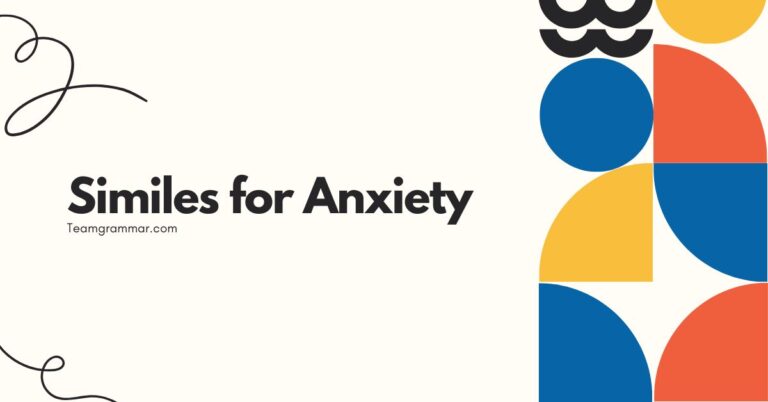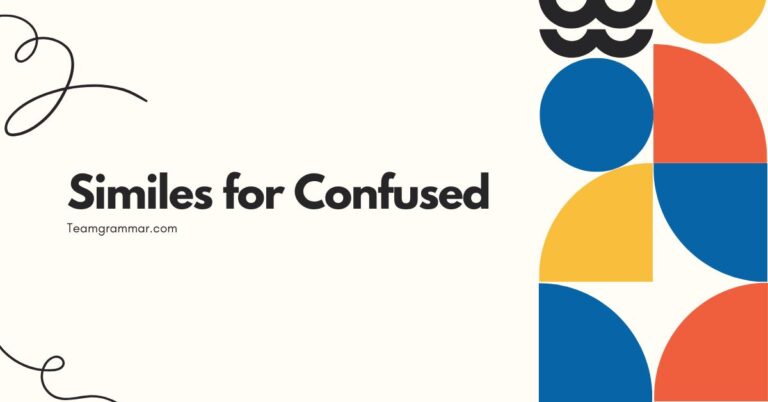41 Similes for Dark: Mastering Figurative Language in English
Understanding similes is crucial for enriching your English vocabulary and enhancing your descriptive writing skills. Similes, by comparing one thing to another using “like” or “as,” allow writers and speakers to create vivid imagery and convey deeper meaning.
This article focuses specifically on similes used to describe “dark,” exploring the nuances of this concept and providing numerous examples to illustrate its versatility. Whether you’re a student, writer, or language enthusiast, this guide will equip you with the knowledge and tools to effectively use similes for “dark” in your communication.
This comprehensive exploration of similes for “dark” will benefit anyone looking to improve their understanding and use of figurative language. By delving into various examples, rules, and exercises, you’ll gain a deeper appreciation for the power and artistry of similes in the English language.
From beginner to advanced learners, this guide offers something for everyone seeking to master this essential aspect of English grammar and style.
Table of Contents
- Definition of Similes
- Structural Breakdown of Similes
- Types and Categories of Similes for Dark
- Examples of Similes for Dark
- Usage Rules for Similes
- Common Mistakes with Similes
- Practice Exercises
- Advanced Topics in Similes
- Frequently Asked Questions
- Conclusion
Definition of Similes
A simile is a figure of speech that compares two unlike things using the words “like” or “as.” The purpose of a simile is to create a vivid and imaginative description by drawing a connection between the two dissimilar subjects. Similes are essential tools in descriptive writing and poetry, allowing writers to evoke specific feelings and paint detailed pictures in the reader’s mind.
In essence, a simile functions as a bridge, linking a familiar concept to a less familiar one to enhance understanding and create a more impactful image. This comparison allows for a deeper engagement with the text, making it more memorable and emotionally resonant.
The effectiveness of a simile hinges on the clarity and originality of the comparison.
Similes are classified as a type of figurative language, specifically within the broader category of analogies. While metaphors also draw comparisons, they do so by stating that one thingisanother, rather than merely beinglikeit.
Understanding the distinction between similes and metaphors is crucial for effective writing and communication.
Structural Breakdown of Similes
The basic structure of a simile consists of three main components: the subject, the linking word (either “like” or “as”), and the comparative element. The subject is the thing being described, the linking word establishes the comparison, and the comparative element is the thing to which the subject is being compared.
For example, in the simile “The night was as dark as coal,” “the night” is the subject, “as” is the linking word, and “coal” is the comparative element. This structure allows for a clear and concise comparison, making the image of darkness more vivid and tangible.
The order of these elements can sometimes be varied for stylistic effect, but the core components remain the same. For instance, one could say, “As dark as coal was the night,” while maintaining the same fundamental comparison.
However, maintaining clarity is paramount when rearranging the elements of a simile.
Types and Categories of Similes for Dark
Similes for “dark” can be categorized based on the specific aspect of darkness they emphasize. These categories can include general darkness, emotional darkness, ominous darkness, and peaceful darkness.
Each category evokes a different feeling and paints a unique picture in the reader’s mind.
General Darkness
Similes that describe general darkness focus on the absence of light and the quality of being dark. These similes often use familiar objects or environments known for their darkness to create a sense of the overall dimness or blackness.
Emotional Darkness
Similes that describe emotional darkness relate to feelings of sadness, despair, or negativity. These similes often use comparisons to things associated with negative emotions, such as shadows, voids, or storms, to convey the depth of the emotional state.
Ominous Darkness
Similes that describe ominous darkness evoke a sense of foreboding or impending doom. These similes often use comparisons to things associated with danger, such as lurking predators, approaching storms, or unknown threats, to create a feeling of unease and anticipation.
Peaceful Darkness
Similes that describe peaceful darkness convey a sense of tranquility and calm. These similes often use comparisons to things associated with rest, such as a quiet night, a gentle shadow, or a soothing blanket, to create a feeling of serenity and relaxation.
Examples of Similes for Dark
Here are several examples of similes for “dark,” categorized by the type of darkness they describe. Each table provides a variety of similes to illustrate the different ways darkness can be portrayed through figurative language.
General Darkness
The following table presents similes that describe general darkness, focusing on the absence of light and the overall quality of being dark. The examples use familiar objects and environments to create a sense of dimness or blackness.
| Simile | Explanation |
|---|---|
| As dark as coal | Compares the darkness to the deep black color of coal. |
| As dark as night | A straightforward comparison to the darkness of the night. |
| As dark as a cave | Compares the darkness to the enclosed and lightless environment of a cave. |
| As dark as pitch | Compares the darkness to the thick, black substance of pitch. |
| As dark as a shadow | Compares the darkness to the absence of light created by a shadow. |
| Like a bottomless pit of darkness | Emphasizes the depth and unending nature of the darkness. |
| As dark as a moonless night | Highlights the absence of moonlight, intensifying the darkness. |
| Dark like the inside of a tomb | Evokes the enclosed and lightless environment of a tomb. |
| As dark as the abyss | Compares the darkness to the infinite and unknown depths of the abyss. |
| As dark as ink | Relates the darkness to the deep black color of ink. |
| Dark like a starless sky | Highlights the absence of stars, intensifying the darkness of the sky. |
| As dark as the depths of the ocean | Compares the darkness to the lightless depths of the ocean. |
| Like a shroud of darkness | Suggests the darkness is enveloping and concealing. |
| As dark as a closed coffin | Evokes the enclosed and lightless environment of a coffin. |
| As dark as a cellar | Compares the darkness to the enclosed and lightless environment of a cellar. |
| As dark as a raven’s wing | Relates the darkness to the deep black color of a raven’s wing. |
| Like a curtain of darkness | Suggests the darkness is descending and obscuring vision. |
| As dark as the back of beyond | Emphasizes the remote and isolated nature of the darkness. |
| Dark like the heart of the forest | Evokes the dense and shadowed environment of the forest. |
| As dark as a guilty secret | Relates the darkness to the hidden and concealed nature of a secret. |
| Like a blanket of darkness | Suggests the darkness is comforting and enveloping. |
| As dark as the devil’s soul | Emphasizes the evil and malevolent nature of the darkness. |
| Dark like a forgotten dream | Evokes the obscure and inaccessible nature of a dream. |
| As dark as a locked room | Compares the darkness to the enclosed and lightless environment of a locked room. |
Emotional Darkness
The following table presents similes that describe emotional darkness, focusing on feelings of sadness, despair, or negativity. The examples use comparisons to things associated with negative emotions to convey the depth of the emotional state.
| Simile | Explanation |
|---|---|
| As dark as despair | Directly compares the emotional state to the feeling of darkness. |
| Like a shadow of grief | Suggests the grief is a constant presence, darkening everything. |
| As dark as a broken heart | Compares the emotional pain to the feeling of darkness. |
| Dark like a soul in torment | Evokes the suffering and anguish of a tormented soul. |
| As dark as a hopeless future | Compares the lack of hope to the feeling of darkness. |
| Like a veil of depression | Suggests the depression is obscuring and concealing joy. |
| As dark as a lonely night | Compares the feeling of loneliness to the darkness of night. |
| Dark like a forgotten memory | Evokes the obscurity and inaccessibility of a forgotten memory. |
| As dark as a hidden sorrow | Compares the concealed grief to the feeling of darkness. |
| Like a pit of despair | Suggests the despair is deep and inescapable. |
| As dark as a haunted past | Compares the painful memories to the feeling of darkness. |
| Dark like a world without love | Evokes the emptiness and desolation of a loveless world. |
| As dark as a starless night sky | Compares the absence of hope to the darkness of the night sky. |
| Like a black cloud of sadness | Suggests the sadness is overwhelming and oppressive. |
| As dark as a tomb of secrets | Compares the concealed truths to the feeling of darkness. |
| Dark like a heart full of pain | Evokes the suffering and anguish of a painful heart. |
| As dark as a world without light | Compares the absence of joy to the feeling of darkness. |
| Like a shroud of melancholy | Suggests the melancholy is enveloping and concealing happiness. |
| As dark as a night without end | Compares the unending despair to the darkness of night. |
| Dark like a soul lost in darkness | Evokes the isolation and hopelessness of a lost soul. |
| As dark as a path without hope | Compares the lack of direction to the feeling of darkness. |
| Like a heavy cloak of sorrow | Suggests the sorrow is burdensome and oppressive. |
| As dark as a dream turned nightmare | Compares the shattered dreams to the feeling of darkness. |
| Dark like a spirit in despair | Evokes the suffering and anguish of a despairing spirit. |
Ominous Darkness
The following table presents similes that describe ominous darkness, focusing on a sense of foreboding or impending doom. The examples use comparisons to things associated with danger to create a feeling of unease and anticipation.
| Simile | Explanation |
|---|---|
| As dark as a gathering storm | Compares the impending danger to the darkness of an approaching storm. |
| Like a shadow creeping closer | Suggests the threat is approaching stealthily and relentlessly. |
| As dark as a predator’s gaze | Compares the impending danger to the intense stare of a predator. |
| Dark like a trap waiting to spring | Evokes the hidden danger and potential for sudden harm. |
| As dark as a secret about to be revealed | Compares the uncertainty to the feeling of darkness. |
| Like a storm cloud on the horizon | Suggests the danger is looming and unavoidable. |
| As dark as a silent threat | Compares the unspoken danger to the feeling of darkness. |
| Dark like a path leading to nowhere | Evokes the uncertainty and potential for danger. |
| As dark as a night before a battle | Compares the anticipation of conflict to the feeling of darkness. |
| Like a spider spinning its web | Suggests the danger is being carefully and deliberately constructed. |
| As dark as a grave waiting to be filled | Compares the impending death to the darkness of a grave. |
| Dark like a forest full of shadows | Evokes the hidden dangers and potential for ambush. |
| As dark as a prophecy of doom | Compares the impending disaster to the feeling of darkness. |
| Like a serpent coiled and ready to strike | Suggests the danger is hidden but imminent. |
| As dark as a heart filled with malice | Compares the evil intentions to the feeling of darkness. |
| Dark like a night haunted by ghosts | Evokes the fear and uncertainty of the supernatural. |
| As dark as a storm brewing within | Compares the inner turmoil to the feeling of darkness. |
| Like a wolf howling at the moon | Suggests the danger is wild and untamed. |
| As dark as a secret buried deep | Compares the hidden truth to the feeling of darkness. |
| Dark like a maze with no exit | Evokes the confusion and potential for being trapped. |
| As dark as a future unknown | Compares the uncertainty to the feeling of darkness. |
| Like a predator stalking its prey | Suggests the danger is relentless and inevitable. |
| As dark as a curse whispered in the night | Compares the impending doom to the feeling of darkness. |
| Dark like a room with no escape | Evokes the feeling of being trapped and helpless. |
Peaceful Darkness
The following table presents similes that describe peaceful darkness, focusing on a sense of tranquility and calm. The examples use comparisons to things associated with rest to create a feeling of serenity and relaxation.
| Simile | Explanation |
|---|---|
| As dark as a quiet night | Compares the calmness to the darkness of a peaceful night. |
| Like a gentle shadow embracing you | Suggests the darkness is comforting and protective. |
| As dark as a soothing blanket | Compares the comforting feeling to the darkness. |
| Dark like a dreamless sleep | Evokes the tranquility and restfulness of deep sleep. |
| As dark as a peaceful void | Compares the absence of stimulation to the feeling of darkness. |
| Like a soft whisper in the dark | Suggests the darkness is gentle and calming. |
| As dark as a starry night sky | Compares the beauty and wonder to the darkness of the sky. |
| Dark like a secret sanctuary | Evokes the feeling of safety and protection. |
| As dark as a moment of reflection | Compares the introspection to the feeling of darkness. |
| Like a warm embrace in the night | Suggests the darkness is comforting and reassuring. |
| As dark as a deep breath before sleep | Compares the relaxation to the feeling of darkness. |
| Dark like a world without worries | Evokes the peace and tranquility of a carefree world. |
| As dark as a quiet forest at night | Compares the stillness and serenity to the darkness. |
| Like a lullaby sung in the darkness | Suggests the darkness is soothing and comforting. |
| As dark as a moment of perfect peace | Compares the tranquility to the feeling of darkness. |
| Dark like a soul at rest | Evokes the calmness and serenity of a peaceful soul. |
| As dark as a sky full of stars | Compares the beauty and wonder to the darkness of the sky. |
| Like a gentle rain falling in the night | Suggests the darkness is cleansing and refreshing. |
| As dark as a secret whispered to the moon | Compares the intimacy and tranquility to the feeling of darkness. |
| Dark like a river flowing silently | Evokes the peace and serenity of a quiet river. |
| As dark as a candle flickering softly | Compares the soft light to the surrounding darkness. |
| Like a gentle hand holding you close | Suggests the darkness is comforting and protective. |
| As dark as a place where dreams are born | Compares the creativity and imagination to the feeling of darkness. |
| Dark like a world of endless wonder | Evokes the mystery and enchantment of the night. |
Usage Rules for Similes
When using similes, it’s important to ensure that the comparison is both clear and effective. The two things being compared should have a recognizable similarity, and the simile should enhance the reader’s understanding or appreciation of the subject.
One common mistake is to use clichéd similes that have lost their impact through overuse. Strive for originality and creativity in your comparisons to make your writing more engaging and memorable.
Avoid phrases like “as dark as night” and try to come up with more unique and evocative comparisons.
Additionally, ensure that the comparison is logical and makes sense within the context of your writing. A simile that is too far-fetched or nonsensical will only confuse the reader and detract from the overall effect.
Key rules to remember:
- Use “like” or “as” to make the comparison.
- Compare two unlike things that share a common quality.
- Avoid clichés and strive for originality.
- Ensure the comparison is logical and clear.
Common Mistakes with Similes
Several common mistakes can undermine the effectiveness of similes. Avoiding these errors can significantly improve the clarity and impact of your writing.
Incorrect: The darkness was like dark. (Redundant comparison)
Correct: The darkness was like a thick blanket.
Incorrect: He ran as fast like a cheetah. (Incorrect use of “like” and “as”)
Correct: He ran as fast as a cheetah.
Incorrect: The night was as dark as light. (Contradictory comparison)
Correct: The night was as dark as a bottomless well.
Incorrect: The simile was like, you know, a comparison. (Unnecessary filler words)
Correct: The simile was a comparison.
The following table illustrates some common mistakes made when using similes, along with corrected examples.
| Incorrect | Correct | Explanation |
|---|---|---|
| The darkness was like black. | The darkness was like a black void. | Avoid redundant comparisons; provide a specific image. |
| She sings good like an angel. | She sings as well as an angel. | Use correct grammar (“as well as” instead of “good like”). |
| The room was dark as a light switch. | The room was dark as a coal mine. | Ensure the comparison is logical and relevant. |
| He is strong like very strong. | He is as strong as an ox. | Avoid vague descriptions; use a concrete comparison. |
| The simile is like, um, a thing. | The simile is a comparison using “like” or “as.” | Avoid unnecessary words and provide a clear definition. |
| The darkness was as dark as dark. | The darkness was as dark as a starless night. | Avoid repetitive wording; choose a vivid comparison. |
| He runs fast like a car. | He runs as fast as a race car. | Provide a specific type of comparison for clarity. |
| The simile is when you use “like”. | The simile is a comparison using “like” or “as”. | Provide a complete and accurate definition. |
Practice Exercises
Test your understanding of similes with the following exercises. Fill in the blanks to complete the similes, or rewrite the sentences to include a simile.
Exercise 1: Complete the Simile
Complete the following sentences with an appropriate simile to describe darkness.
| Question | Answer |
|---|---|
| 1. The room was as dark as __________. | 1. The room was as dark as a coal cellar. |
| 2. The night sky was like ___________. | 2. The night sky was like a black velvet cloth. |
| 3. His mood was as dark as __________. | 3. His mood was as dark as a thundercloud. |
| 4. The forest was dark, like __________. | 4. The forest was dark, like a hidden world. |
| 5. The secret was as dark as __________. | 5. The secret was as dark as a buried sin. |
| 6. The tunnel was as dark as __________. | 6. The tunnel was as dark as the inside of a coffin. |
| 7. The future seemed like ___________. | 7. The future seemed like a path into the unknown. |
| 8. Her eyes were as dark as __________. | 8. Her eyes were as dark as the depths of the ocean. |
| 9. The feeling of despair was like __________. | 9. The feeling of despair was like a heavy stone in his chest. |
| 10. The shadows were as dark as __________. | 10. The shadows were as dark as ink spilled on paper. |
Exercise 2: Rewrite with a Simile
Rewrite the following sentences to include a simile that describes darkness.
| Question | Answer |
|---|---|
| 1. The night was very dark. | 1. The night was as dark as a bottomless well. |
| 2. The room was completely black. | 2. The room was dark like the inside of a camera. |
| 3. His thoughts were gloomy. | 3. His thoughts were as dark as a stormy sea. |
| 4. The cave was incredibly dim. | 4. The cave was dark, like the belly of a beast. |
| 5. The future looked hopeless. | 5. The future looked as dark as a moonless night. |
| 6. The forest was shrouded in darkness. | 6. The forest was dark, like a world forgotten by the sun. |
| 7. The cellar was pitch black. | 7. The cellar was as dark as a coal mine at midnight. |
| 8. Their secret was deeply hidden. | 8. Their secret was as dark as the deepest ocean trench. |
| 9. The mood in the room was somber. | 9. The mood in the room was dark like a funeral procession. |
| 10. The alleyway was unlit. | 10. The alleyway was as dark as the depths of despair. |
Advanced Topics in Similes
For advanced learners, exploring the nuances of similes can involve analyzing their cultural and historical contexts. Different cultures may have different associations with darkness, which can influence the interpretation of similes.
Understanding these cultural nuances can enrich your understanding of literature and communication.
Furthermore, advanced learners can experiment with creating complex and multi-layered similes that incorporate multiple comparisons and metaphors. This can create a richer and more nuanced description, but it requires careful attention to clarity and coherence.
Another area for advanced exploration is the use of similes in different genres of writing. The effectiveness of a simile can vary depending on the genre and the intended audience.
Analyzing how similes are used in poetry, fiction, and non-fiction can provide valuable insights into their versatility and impact.
Frequently Asked Questions
Here are some frequently asked questions about similes, particularly those related to describing “dark.”
- What is the difference between a simile and a metaphor?
A simile compares two things using “like” or “as,” while a metaphor states that one thing is another. For example, “The night was as dark as coal” (simile) versus “The night was a black canvas” (metaphor).
- Why are similes important in writing?
Similes enhance descriptions, evoke emotions, and make writing more engaging and memorable. They allow writers to create vivid imagery and convey deeper meaning.
- How can I avoid using clichéd similes?
Strive for originality by thinking of unique and unexpected comparisons. Consider the specific qualities of “dark” you want to emphasize and find less common objects or concepts to compare it to.
- Can a simile be too complex?
Yes, a simile that is too convoluted or far-fetched can confuse the reader. Aim for clarity and ensure that the comparison is logical and relevant to the context.
- What are some common words used in similes for “dark”?
Common words include “coal,” “night,” “shadow,” “cave,” and “pitch.” However, don’t limit yourself to these; explore other possibilities to create more original similes.
- How do I choose the right simile for a particular situation?
Consider the tone and purpose of your writing. If you want to create a sense of foreboding, use similes that evoke danger or uncertainty. If you want to create a sense of peace, use similes that evoke tranquility and calm.
- Are similes only used in creative writing?
No, similes can be used in various forms of writing, including persuasive essays, speeches, and even scientific reports, to make complex ideas more accessible and engaging.
- How can I practice using similes effectively?
Practice writing similes regularly, experimenting with different comparisons and seeking feedback from others. Read widely and pay attention to how similes are used in different types of writing.
- Can similes be used to describe abstract concepts?
Yes, similes can be used to describe abstract concepts like emotions, ideas, or experiences by comparing them to concrete objects or situations.
- What makes a simile effective?
An effective simile is clear, original, and relevant to the context. It enhances the reader’s understanding or appreciation of the subject and creates a vivid and memorable image.
Conclusion
Mastering similes for “dark” involves understanding the nuances of figurative language and the power of comparison. By exploring various examples, usage rules, and common mistakes, you can effectively enhance your descriptive writing and evoke specific emotions in your audience.
Remember to strive for originality, clarity, and relevance in your similes to make your writing more engaging and memorable.
Practice is key to mastering the art of using similes. Experiment with different comparisons, seek feedback from others, and read widely to expand your vocabulary and understanding of figurative language.
With dedication and effort, you can become proficient in using similes to create vivid and impactful descriptions in your writing and communication.







